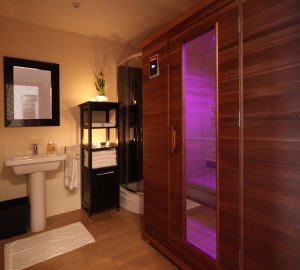The benefits and advantages of owning an infrared home sauna are well known and more and more people take the decision to invest in  one of these to improve their health and quality of life.
one of these to improve their health and quality of life.
However, finding reliable and understandable advice about the difference in quality, price and safety of the different products that are out there is not easy. An endless list of infrared sauna sites can be found on the internet but the information offered is often contradicting and biased to say the least.
In the post below, we have made an attempt to provide some useful information that should help with the process of picking your own home infrared sauna. Since the infrared heaters are arguably the most important part or the sauna, we decided to start with these and this post focusses on different heater technologies and what to look out for when picking a heater.
Basic Laws of Physics
When assessing the quality of an infrared sauna heater, these 4 basic but important laws of physics can be very helpful. More detail about them can be found on Wikipedia and other internet sources
- Infrared light with a wavelength above 5.5 microns is considered far infrared light
- The higher the heater surface temperature, the more infrared energy is radiated.
- Most objects radiate and absorb infrared light. However, objects do not absorb all infrared light at the same degree. Every object has its own ‘internal’ infrared wavelength. The human body’s infrared is believed to vary between 5 and 16 microns, while water (70-90% of our body) has a wavelength of 4-8 microns.
- The wavelength of infrared light emitted by a heater is a direct result of the surface temperature of that heater. A very high temperature will emit shorter wavelengths of infrared light. This principle is explained in several physics laws (Planck’s law, Wien’s displacement law and Stefan Boltzman’s law) The formula of Planck’s law is:
IE(Infrared Emission) = 5269/ (HEATER FACE TEMP + 460) (temperatures are in Fahrenheit)
The above laws of physics teach us a couple of very important things:
– Any infrared sauna heater should emit far infrared light of a wavelength above 5.5 microns to be able to be absorbed by the human body effectively
– Infrared sauna heaters should have a high surface temperature to maximise the amount of infrared light generated.
– The wavelength of the infrared light that is being generated by the heater should be as close as possible to that of the human body.
– Infrared sauna heaters should have a high surface temperature. Infrared light works at low temperatures, but to have a comfortable sauna effect, generate sweat and detoxify, the heaters should be capable of warming up the sauna cabin to temperatures above 50 degrees quickly and efficiently.
The obvious challenge for infrared sauna heater manufacturers is to create a heater that is as hot as possible but not so hot it does not generate far infrared light anymore.
Tip: Planck’s law is a great tool to verify certain claims made on the internet. For example “heaters that emit infrared light of 9.5 microns”. This would mean that the surface temperature of your heater cannot be more than 100 Fahrenheit or 37 degrees Celsius. You are unlikely to experience much of a sauna or detoxification effect at these temperatures and not much infrared light will be generated at 37 degrees Celsius.
Infrared Heater in the Sauna Cabin:
– Infrared light should come from all angles. Heaters should be installed in the back, front and left and right of the benches.
– Infrared heaters should have reflective panels to reflect the heat back into the cabin and avoid the loss of 50% of the infrared light.
– Heaters should be covered to avoid burns.
– Heaters need sufficient insulation and installation needs to be done with the necessary expertise to avoid fire hazard. Use a reputable manufacturer!
– Heaters should be developed specifically for infrared sauna use and not ‘borrowed’ from other industry applications. Example: cheap carbon heaters where developed to dry paint in the car manufacturing industry and are now commonplace in cheap infrared sauna cabins.
– Heaters should not contain toxic material.
TIP: Always find out who the manufacturer is! None of the infrared sauna companies in the market today manufacture their own heaters. They are all depending on third party manufactures. A minority use patented technology from EU or US suppliers. 90% of all heaters are imported from the Chinese market. This unfortunately also includes fake copies of patented heaters.
Reliability, quality and safety
– Most heaters in the market have a life expectancy of 2-5 years. Make sure your heaters come with a manufacturer’s warranty exceeding 5 years.
– Heaters should have the necessary industry certifications. CE is the minimum. Ask for more, the fact that a manufacturer goes through the considerable trouble of obtaining certification can be an indication that they are a serious company.
– Ask whether the seller holds public liability insurance. Again, this can be an indication that you are dealing with a serious company.
TIP: There is no way for you to measure the effectiveness and quality of a heater. The only way to be reasonably sure is to try it out. Some sellers offer trials and you may be able to find other brands in spas or gyms near you. It is worth investing the time to try out a couple of alternatives don’t rely on a salesperson’s advice alone. And don’t forget: Always make sure you find out who the manufacturer is.